The Subzero Lab
The Subzero Lab is a world-class resource for snow science and other areas of study that demand a controlled cold environment. Housed in 2,700 square feet on the first floor of Cobleigh Hall at MSU's College of Engineering, the Subzero Lab includes several specialized facilities and pieces of equipment found few other places in the world.
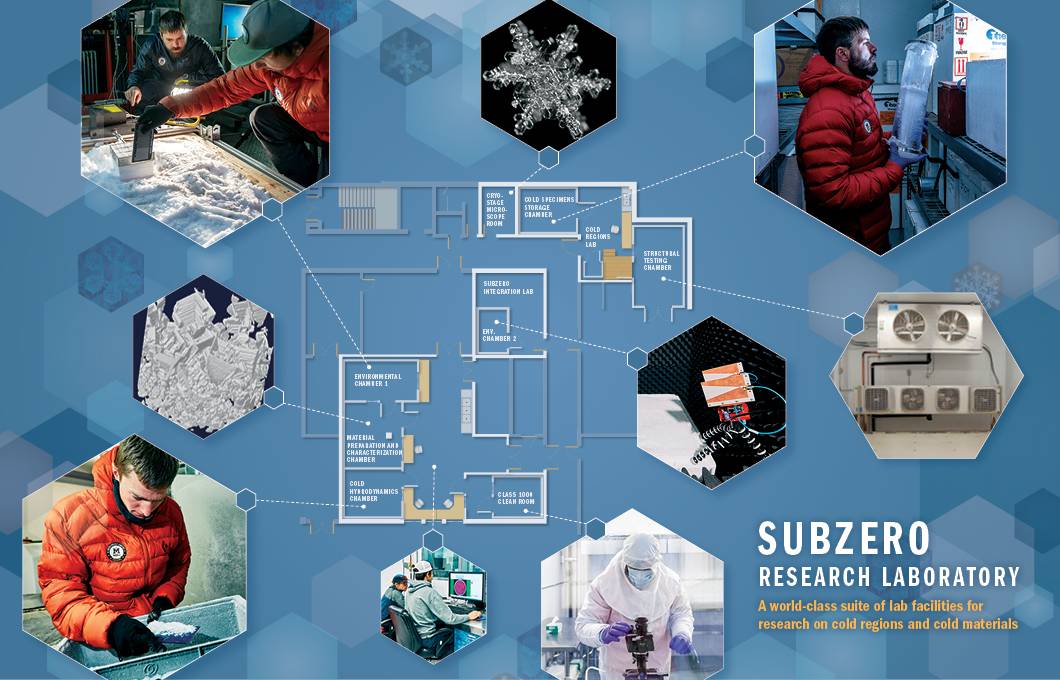
Download the Subzero Lab brochure.
Facilities and Equipment
In addition to these descriptions of the rooms, we have detailed descriptions of featured instruments.
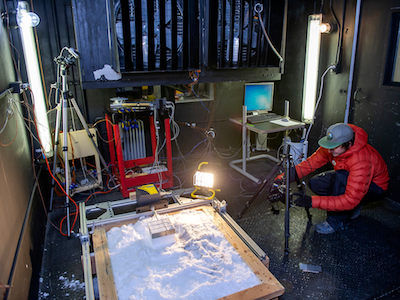
Environmental Chamber 1
Featuring solar simulation, humidity control and variably control of radiative temperature in floor and ceiling, this general-purpose chamber supports a experiments on subjects such as snow metamorphism and avalanche mechanics.
Temperature: -40°C to 10°C (± 1°C), a spatial uniformity of ±2°C, Ceiling Temperature: -10°C to -50°C, Simulated Solar: 0 to 1200 W/m2, Room Size: 3 m x 4.3 m (10’ x 14’ x 7')
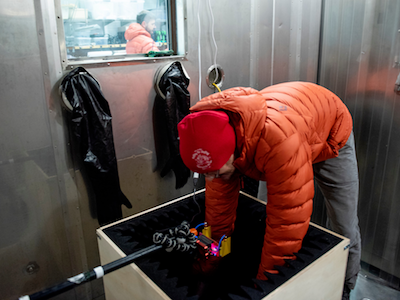
Environmental Chamber 2
Capable of sustaining temperatures as low as -60C, this is the coldest chamber in the Subzero Lab. In-place gloves allow researchers to handle equipment from outside chamber.
Temperature: -68°C to 60°C (± 1°C). Simulated Solar: 0 to 1200 W/m2, Room Size: 1.8 m x 2 m (6’ x 6.5’) with exterior glove box mounts.
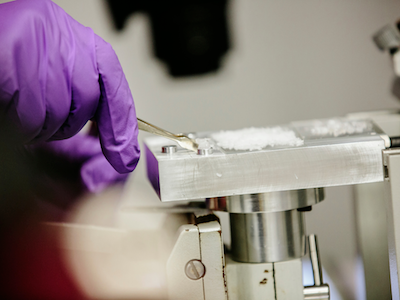
Materials Preparation and Characterization Chamber
Adjacent to Environmental Chamber 1, this cold room contains a variety of equipment for preparing and analyzing ice and snow samples, including a powerful microCT device.
Temperature: -30°C to 10°C (± 2°C), a spatial uniformity of ±2 ◦C, Room Size: 4.3 m x 4.9 m (14’ x 16’).
General specimen preparation is performed with a precision bandsaw, a polarized light table, biological sledge microtome, and a stereographic microscope. For creating parallel surfaces, either a flat mill or the microtome is used. Room also contains a Bruker Skyscan 1173 X-ray computed microtomography system.
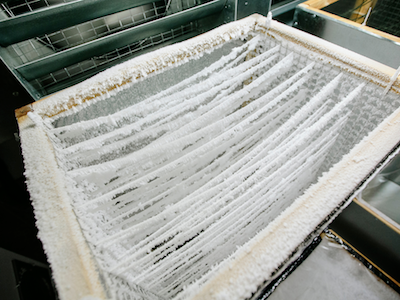
Cold Hydrodynamics Chamber
Allows researchers to study systems with liquid water in a controlled cold environment. Includes programmable solar simulator in the ceiling and a snow-making device.
Temperature: -25°C to 10°C (± 2°C), a spatial uniformity of ±2 ◦C, Simulated Solar: 0 to 1200 W/m2, Room Size: 3.7 m x 4.3 m (12’ x 14’)
Primarily used to create dendritic-type snow crystals in bulk, the cold hydrodynamics chamber utilizes a temperature controlled de-ionized water reservoir, which provides a steady flow of water to the chamber. Other applications include the study of wetland and permafrost environments. This room also has a solar simulation source.
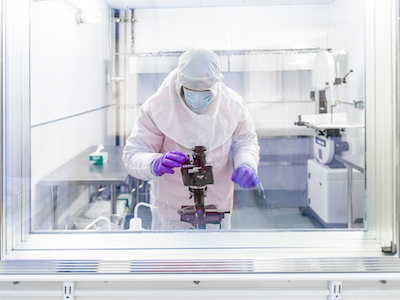
Class 1000 Clean Room
Provides a contaminant-free space for processing pristine ice core samples and conducting microbial experiments.
Temperature: -20°C to 10°C (± 2°C), a spatial uniformity of ±2°C, Room Size: 3 m x 3.7 m (10’ x 12’).
Decontamination of ice cores and the study of organic and inorganic impurities in snow and ice is made possible with a Class 1000 clean room, which also houses a hooded Class 100 partition. This room provides space for the processing of pristine ice core samples and for conducting microbial related experiments.
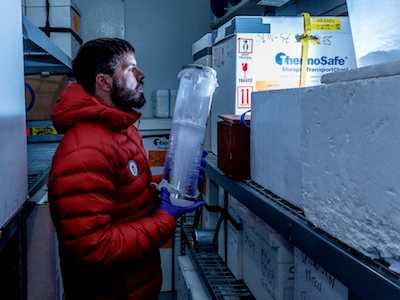
Cold Specimens Storage Room
Cold chamber with redundant refrigeration system provides assured long-term storage for ice cores and other frozen samples.
Temperature: -30°C (± 1°C), Room Size: 3 m x 4.3 m (10’ x 14’)
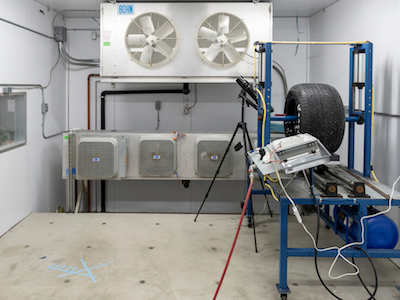
Structural Testing Chamber
Features a concrete floor with bolt-down points, allowing for applying forces to materials under variable cold conditions. Ideal for studying durability and other characteristics of materials such as concrete in low temperatures.
Temperature: -40°C to 10°C (± 2°C), a spatial uniformity of ±2°C, Room Size: 3.7 m x 6 m (12’ x 20’).
This room contains an integrated “strong floor” with tie downs to test structural materials and elements at low temperatures, explore new materials, test durability of existing materials and explore the manufacture of innovative structural materials to be used in cold environments.
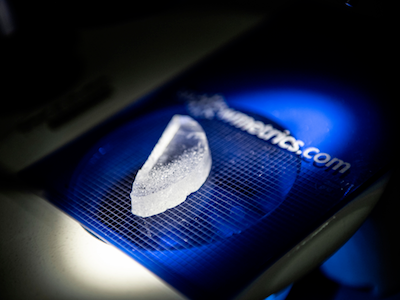
Cryostage Microscope Room
Non-cold room houses multiple specialized, powerful microscopes with localized temperature control.
At the center of this facility is a Nikon Eclipse 80i epifluorescence microscope. The microscope contains a digital imaging head with dual ports including an internal zoom optical system (0.8 to 2.0x), built-in Siedentopf binocular body, integrated universal epifluorescence system, ports for two detectors and an elextronic shutter.
Objectives: (1) CFI Plan Fluor 4x/0.13NA WD 17.1 mm, (2) CFI Plan Fluor 10x/0.03NA WD 16 mm, (3) CFI Plan Fluor 20x/0.45C ELWD 7.6 mm, (4) CFI Plan Fluor 40x/0.60 ELWD with correction collar 0-2 mm: working distance 2.9 to 5 mm and (5) CFI Plan Fluor 100x/1.3NA WD 0.2 mm oil.
Camera: T-PS24HS PAXcam ARC 20 MPixel w/LINKAM interface.
Cryostages (for up to 1000x magnification in either brightfield or fluorescence mode): (1) Linkam L-MDBCS196 motorized cryobiology pro-stage system, (2) Linkam L-GS120 temperature gradient stage system
